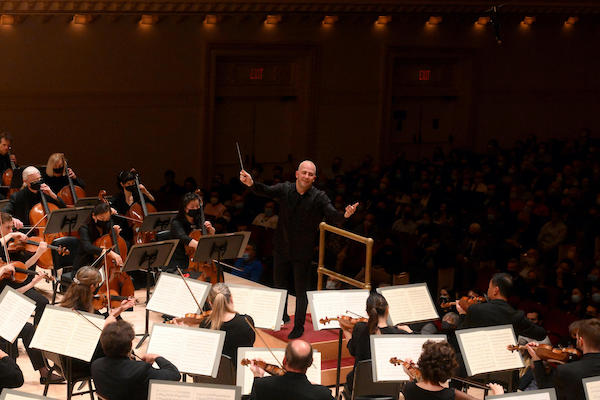A dance of elephants in third program of Philly Beethoven cycle

Any explanation for why the Philadelphia Orchestra’s performances of Beethoven’s Symphonies No. 7 and No. 8 at Carnegie Hall Tuesday night was so misguided has to start at the podium. One wonders just what it is conductor Yannick Nézet-Séguin hears in the music.
In one sense, the answer is obvious. The sonic evidence Tuesday established that he hears Beethoven as something that mostly goes fast and is played loudly, with dominating, athletic energy. While the energy part is good, the problem is, of course, that there’s so much more to Beethoven, and so much more this orchestra can do—as they showed with contemporary composer Carlos Simon’s short piece, Fate Now Conquers.
The Philly group has been in Carnegie this fall, making up for the lost 2020-2021 season with a Beethoven cycle and associated new commissions—like Simon’s—that would have been heard for the composer’s 250th anniversary in 2020. Perhaps there’s a sense of making up for lost time that had the music coming at such a one-dimensional rush, like a person trying to say three words at once, and stumbling into some weird conglomeration. Not that the playing was clumsy, but it came out as a blunt babble.
Though a later work, Symphony No. 8 was first up because it is shorter and relatively lighter than the Seventh. But it is substantial in and of itself. It is often describe as a temporary return to the classical style of Symphonies 1 and 2, but that his more to do with how the piece is mainly about the notes, without an obvious narrative or dramatic idea. But it’s still Beethoven, with brilliant rhythmic inventiveness and a crackly sense of tension and release.
That is, if one can hear that. Nézet-Séguin arrayed a full-sized orchestra, in the modern sense, and the sound was too loud, too big, and too unbalanced for the agile, poised music; the brass and winds drowned out the entire string section at both the statement and recapitulation of the initial idea.
The first movement is built on simple materials fitted into some of the composer’s finest rhythmic explorations—he pushes the pulse and footing of the triple meter, letting it build some intense and exhilarating tension. Nézet-Séguin did underline some of these moments, but the playing was extremely heavy. Not sluggish—it was energetic—but it was all mass, power, and force, like an elephant charging through a dance hall.
If Symphony No. 8 is to be thought of as classical, then the playing has to emphasize the dance, but the heaviness made it clumsy. The feel in the Minuet was all wrong, though the horn duet was one of the best parts of the rendition. That gave way, though, to a finale that was just speed and bludgeoning. There was little sense of form across the entire work, with identifiable sections treated as episodes, not connecting parts of a larger work.
Symphony No. 7 was too fast throughout, except when it was too slow. It is impressive to see such a large complement of modern stringed instruments playing, and articulating, at the far end of markings like vivace and presto, but the result was a mass of sound that had no nuance or charm in the phrasing, little in the way of any consideration of what the music might possibly express, emotionally or intellectually.
The too-slow part was the Allegretto, which Nézet-Séguin took at a tempo closer to andante. The Allegretto is some of the most exquisite music Beethoven ever wrote; like “Mir ist so wunderbar” or the last movement of Piano Sonata No. 32, it speaks so eloquently for itself that too much intervention ruins it. The music presents tragedy, peace, and determination in wrenching combination, but Nézet-Séguin’s tempo shouted out the obvious, confused pathos for meaning, and made it vulgar in what was the low point of the evening.
After this, the dances of the final two movements were an oppressive stampede that reminded one of Shostakovich’s explanation for his Symphony No. 5, where one is beaten and ordered to rejoice until one goes through the motions of rejoicing, feeling nothing inside.
Against this, the performance of Simon’s Fate Now Conquers was exceptional. Simon wrote this to connect the two Beethoven symphonies, and the title quotes from The Odyssey, an important work to Beethoven.
The music leaps into action and lopes into the future, has a sense of curiosity, adventure, equipoise, and a tremendous balance of form and details—every sound and gesture has a meaning and purpose, and connects to everything else. The orchestration is also superb, colorful and imaginative but all in the purpose of the music, not a work about how things can sound, but five minutes of concentrated musical and expressive logic. The playing was skillful and sensitive, and brought out all the nuances in the score. One felt one heard what Simon intended, and the audience’s ovation for the composer confirmed that.
The Philadelphia Orchestra and conductor Yannick Nézet-Séguin perform Beethoven’s Symphonies No. 2 and 3, and Jessica Hunt’s Climb, 8 p.m. December 7 carnegiehall.org







